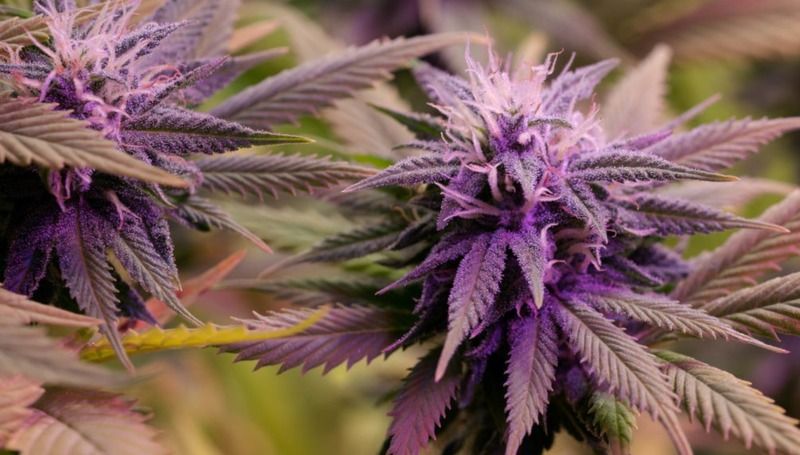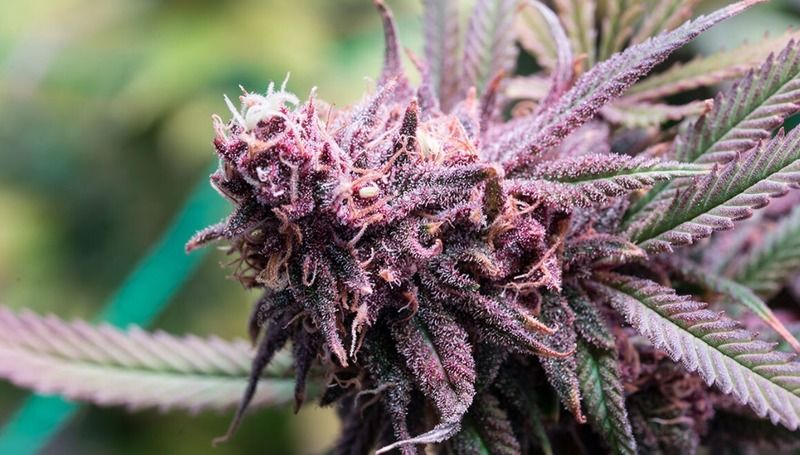The leaves of certain strains of marijuana contain a lot of anthocyanins, which are pigment molecules that cause them to turn purple. Anthocyanins are water-soluble natural pigments present in many plants. They give blueberries their hue as well as blackberries and red grapes. Looking to try something new? Check out this.
Anthocyanins are present in cannabis as well. These pigment compounds give cannabis buds a variety of colors.
Cannabis has a pigment known as anthocyanin. It comes in a wide range of hues, including red, gold, dark green, blue, and black. Cannabis’ color is determined by the plant’s genetics and farming methods. Many variables influence the color and durability of anthocyanin pigments, such as temperature, light, pH level, and structure.
Cannabis leaves may change color as the plant matures, just as leaves do in the fall. This occurs when you consider a cannabis crop developing in nature.

Anthocyanins are commonly found in high amounts in certain strains. Certain circumstances, such as the strain’s transition into the “blooming” cycle, expose these strains’ beautiful purple tones. This is a consequence of a plant’s genotype and external environmental variables influencing one another.
What Are Anthocyanins?
Anthocyanins are a kind of phytochemicals that belong to the flavonoid family. Flavonoids are plant chemicals present in fruits, veggies, grains, teas, and nuts. They’re also found in cannabis plants along with two additional kinds of compounds: cannabinoids and terpenes.
Anthocyanins are also credited with health advantages including improving eye and cognitive health. “Scientific research, such as cell culture studies, animal models, and human clinical trials, reveal that anthocyanidins and anthocyanins have antioxidant and antibacterial properties that improve visual and neurological health while also protecting against noncommunicable illnesses,” according to Khoo et al.
Anthocyanins, as well as other flavonoids, have been shown to have anti-inflammatory and antioxidant effects. Anthocyanins may help protect the heart and liver while also aiding in weight reduction and diabetes prevention.
For thousands of years, plants high in anthocyanin have been used as herbal medicines. These naturally occurring therapies were utilized by North American, European, and Chinese ancient civilizations in the past.
Is purple grass superior to green marijuana for health? Unfortunately, probably not. The majority of anthocyanins are absorbed through the stomach. As a result, to see any substantial change, you’d have to consume a lot of edibles. Probably not the greatest choice!
Are Purple Strains Healthier?
The antioxidant content of purple cannabis flowers is higher. In order to obtain any benefit from their antioxidants, you’d need to eat a large number of buds. Not suggested!
Purple plants have lower levels of THC, although high-THC purple strains are possible to cultivate. Matt Gosling, a seasoned breeder, says that the purple strains available for purchase in dispensaries are the result of great genetics rather than stress. Consumers recall purple strains. However, Gosling warns that attempting to breed a plant with a more vivid hue may actually reduce its potency and therapeutic efficacy.
Myths
- Stressing A Strain Will Turn It Purple
If the plant doesn’t receive adequate nutrients for growth, cannabis leaves are occasionally said to acquire a purple tinge. They’re made up of potassium, phosphorus, oxygen, carbon dioxide, and nitrogen. In fact, removing nourishment from them would be fatal to the plants.
- Freezing A Strain Will Turn It Purple
It’s not suggested that cannabis plants be subjected to flash freezing or ice water flushes. It may both lower the THC content and destroy the plants. Finally, I’m at a loss as to how anyone could believe this, but….
- You Can Dye Your Cannabis Purple With Food Coloring
Obviously, this would be a waste of time and resources, so I’d want to know who came up with it.
How do Anthocyanins Affect Plant Appearance?
The color of the leaves and stems is determined by anthocyanins, which are produced for just a few weeks at the end of a plant’s life and only begin to alter its appearance near the conclusion. Because there isn’t as much chlorophyll in the final stages, the colors become more vivid.
When days become shorter and nights longer, photoperiod-dependent plants are told to stop producing chlorophyll (which is required for photosynthesis and vegetative growth) so that energy may be directed exclusively towards developing flowers and, eventually, fruits. As chlorophyll is broken down and removed from the plant’s tissues, brilliant purple, blue, and red hues emerge as anthocyanins accumulate.
Cannabis plants with little anthocyanins are frequently colored at the end of the blooming cycle. The gold, orange, and ochre hues that appear in many cannabis strains prior to harvest – while yellowing in the vegetative period or early flowering is generally a symptom of illness or deficiency – are completely natural throughout later floral phases.
It’s possible that this is the result of a malfunctioning carotenoid-responsive gene. This family of approximately 600 chemicals ranges in color from pale yellow to deep orange-red. Carotenoids are produced throughout the plant’s life cycle and are present at higher levels in later phases as a consequence of chlorophyll reduction rather than an increase in pigment synthesis.
Maximum Yield Explains Purple Cannabis
Anthocyanins are water-soluble pigments that may be red, purple, dark blue, or black depending on the pH in plants.
The color of cannabis plants is determined by a variety of factors, including genetics, chemicals, and natural components. Higher alkaline soil prevents plants from absorbing anthocyanins, necessitating a neutral or slightly acidic pH level. However, it is tough to create a purple-colored plant without having a genetic propensity towards purpleing.
Cannabis plants’ color transformation from green to purple might be compared to leaves turning orange in the fall. The purple hues that are frequently hidden by the green as chlorophyll (the substance that gives plants their green color) evaporates in the final stages of a cannabis plant’s life cycle begin to emerge. The calyx, pistils, and leaves all have the potential to develop into purples. In harvested flowers, the curing process promotes chlorophyll breakdown, allowing for greater visibility of purple hues.
